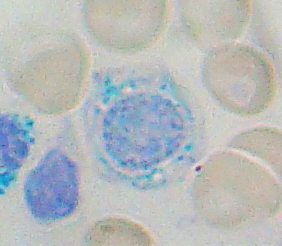Sideroblastic anaemia
| Sideroblastic anemia | |
|---|---|
 |
|
| A ring sideroblast visualized by Prussian blue stain | |
| Classification and external resources | |
| Specialty | hematology |
| ICD-10 | D64.0-D64.3 |
| ICD-9-CM | 285.0 |
| OMIM | 301310 206000 300751 |
| DiseasesDB | 12110 |
| MeSH | D000756 |
Sideroblastic anemia or sideroachrestic anemia is a form of anemia in which the bone marrow produces ringed sideroblasts rather than healthy red blood cells (erythrocytes). In sideroblastic anemia, the body has iron available but cannot incorporate it into hemoglobin, which red blood cells need to transport oxygen efficiently. The disorder may be caused either by a genetic disorder or indirectly as part of myelodysplastic syndrome, which can evolve into hematological malignancies (especially acute myelogenous leukemia).
Sideroblasts ( + ) are atypical, abnormal nucleated erythroblasts (precursors to mature red blood cells) with granules of iron accumulated in the surrounding the nucleus. Normally, sideroblasts are present in the bone marrow, and enter the circulation after maturing into a normal erythrocyte.
Ring sideroblasts are named so because iron-laden mitochondria form a ring around the nucleus. To count a cell as a ring sideroblast, the ring must encircle a third or more of the nucleus and contain five or more iron granules, according to the 2008 WHO classification of the tumors of the hematopoietic and lymphoid tissues.
The WHO International Working Group on Morphology of MDS (IWGM-MDS) defined three types of sideroblasts:
Sideroblastic anemia is typically divided into subtypes based on its cause.
GLRX5 has also been implicated.
Symptoms of sideroblastic anemia include skin paleness, fatigue, dizziness, and enlarged spleen and liver. Heart disease, liver damage, and kidney failure can result from iron buildup in these organs.
Causes of sideroblastic anemia can be categorized into three groups: congenital sideroblastic anemia, acquired clonal sideroblastic anemia, and acquired reversible sideroblastic anemia. All cases involve dysfunctional heme synthesis or processing. This leads to granular deposition of iron in the that form a ring around the nucleus of the developing red blood cell. Congenital forms often present with normocytic or microcytic anemia while acquired forms of sideroblastic anemia are often normocytic or macrocytic.
...
Wikipedia
